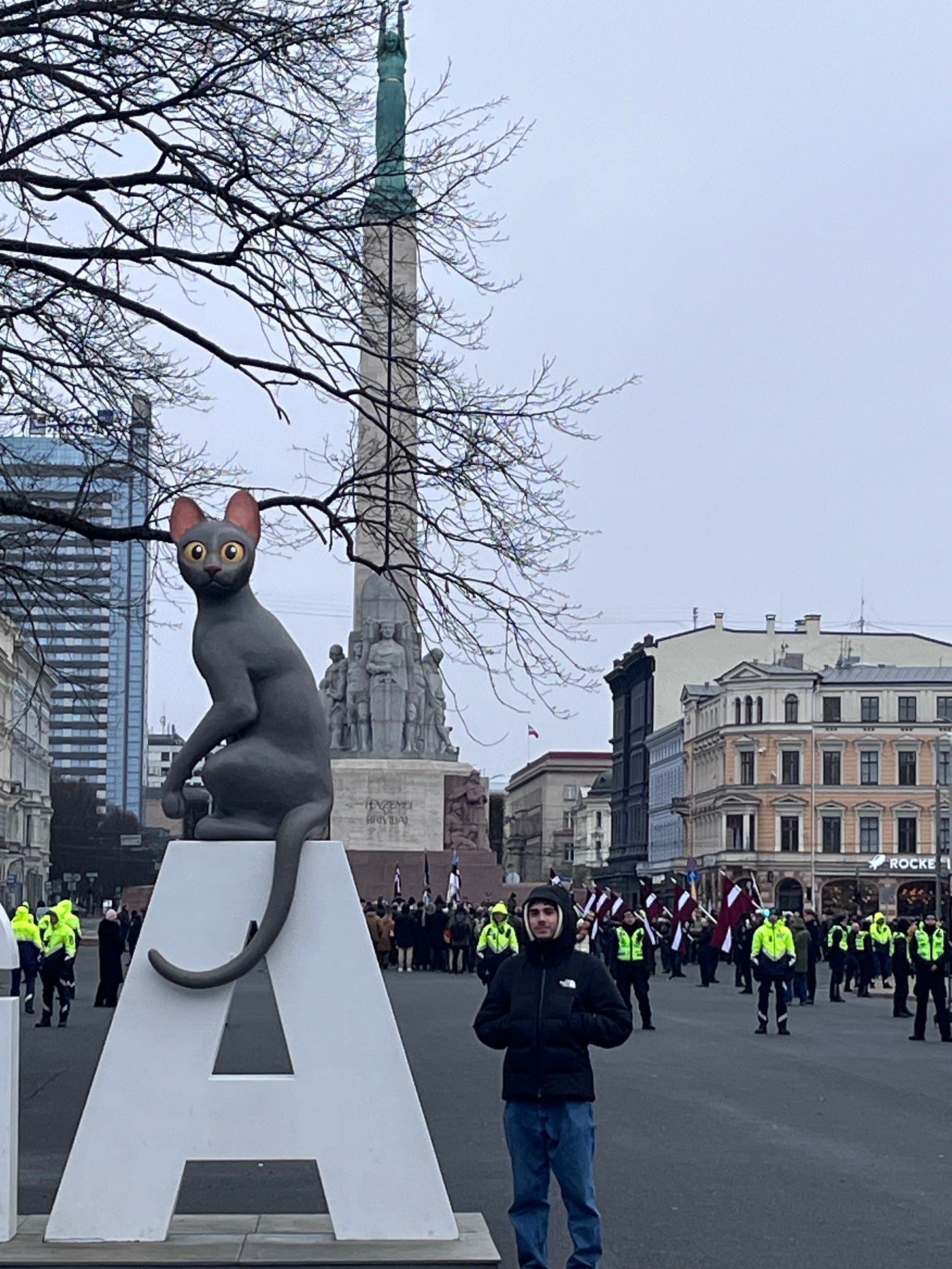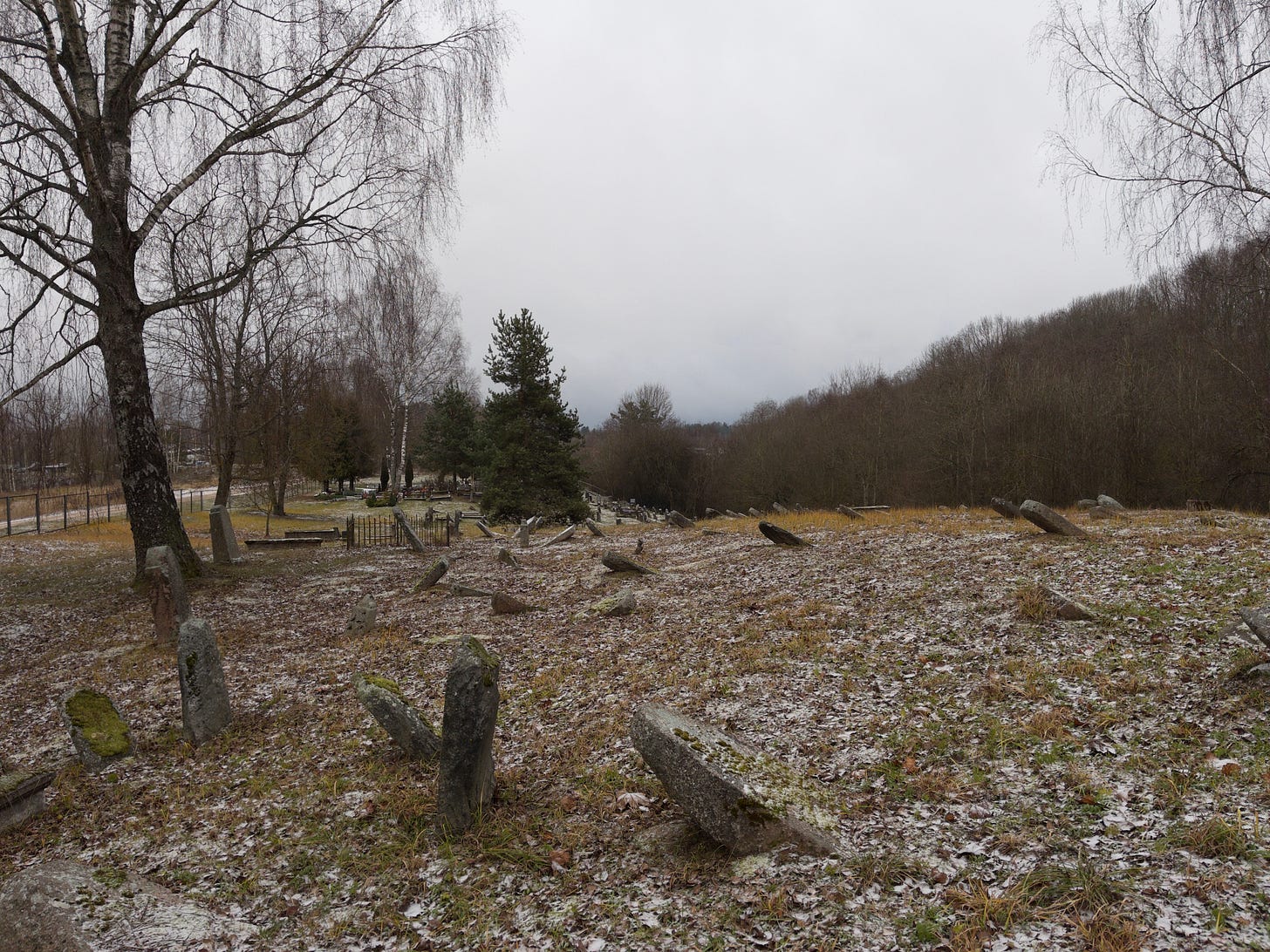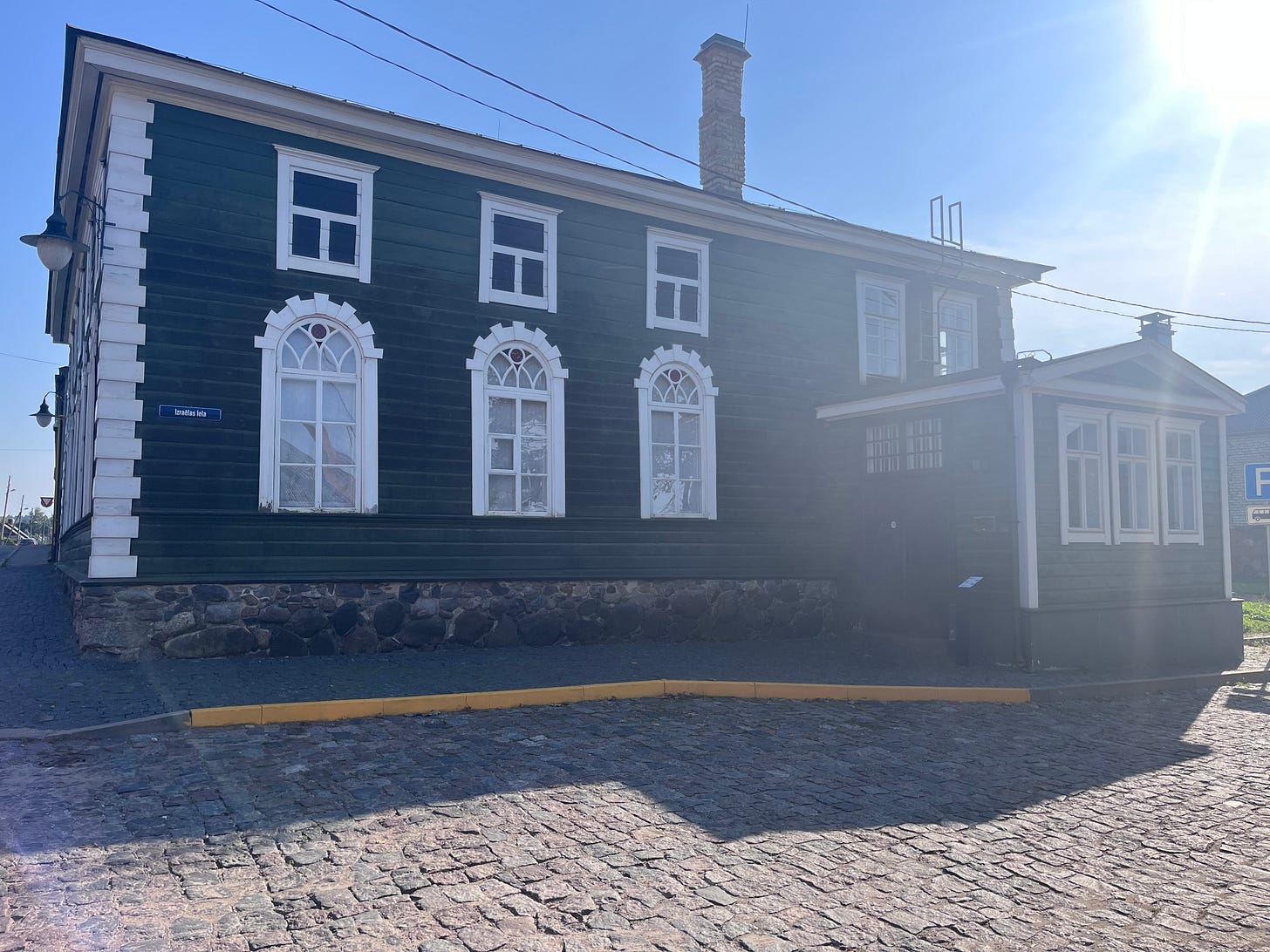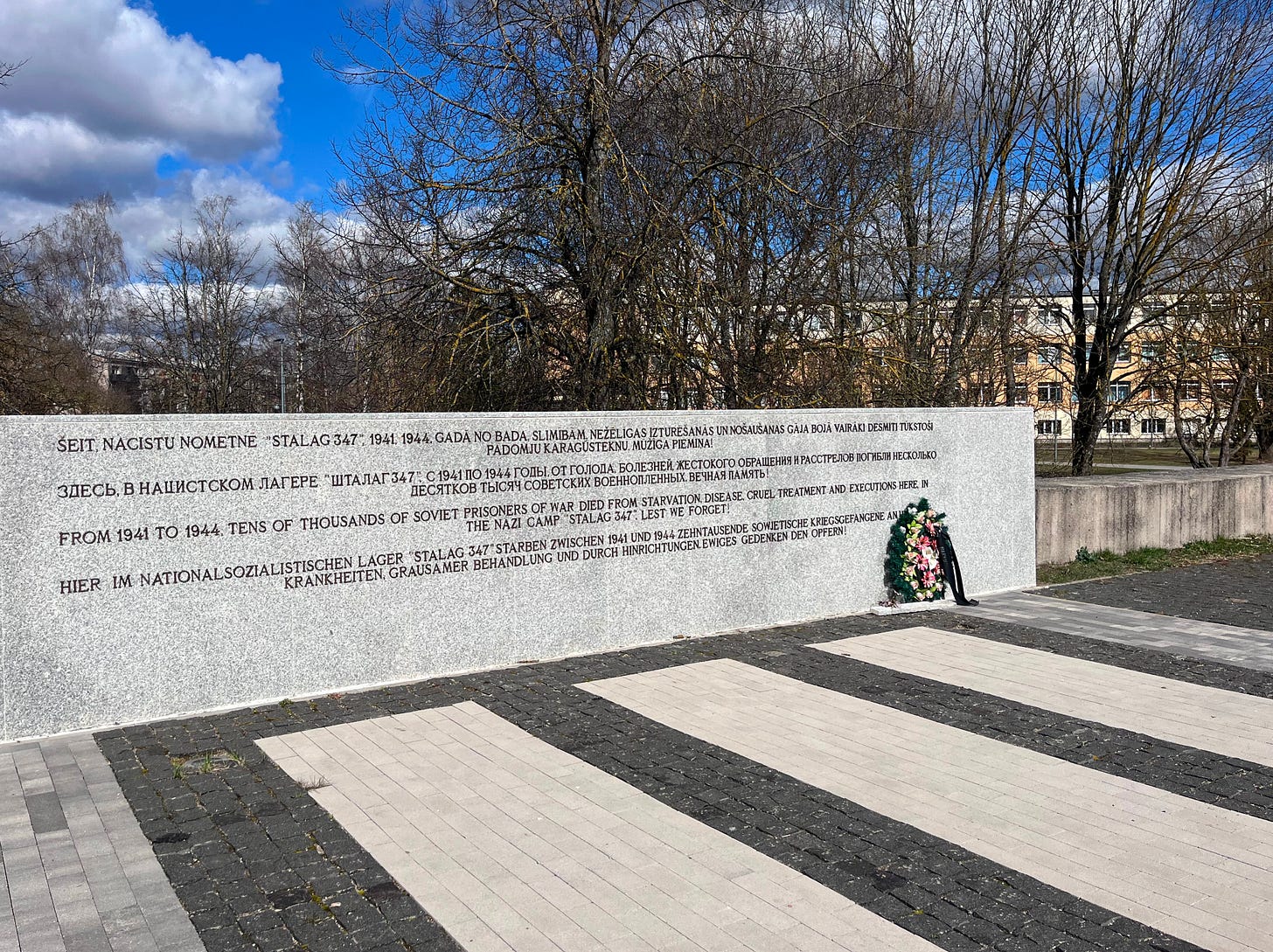The Lead
It took me six months to learn that I’ve been playing volleyball on the site of a concentration camp.
I found out during a Russian lesson when my tutor and I were discussing how Latvians and Russians in Latvia have different collective memories of World War II. She spoke in absolutes. For Russians, she said, World War II was the greatest sacrifice a nation could make. Accordingly, Victory Day on May 9th is the most important holiday on the calendar. Latvians, she said, generally liked the Germans better.
My Russian is not really good enough to challenge her on any of this with deftness, so I mostly listened and wrote down words I didn’t understand. First came “сразу,” which translates to “straightaway” or “at once.” Then, “кирпич,” which means “brick.” As she continued her mini-soliloquy on World War II, which seemed both based on a selective reading of history and ethnic loyalty, she mentioned а “концлагерь” in Rēzekne next to school #5. “Концлагерь” translates to “concentration camp.”
I questioned the translation’s accuracy, but she insisted it was right. At the end of the lesson, I still figured I had misunderstood something.
As I’ve written on this blog before, I’ve been playing a lot of volleyball — three-hour practices twice per week. The walk to the gym is about a half hour each way. I know it well. That night after my Russian lesson, I veered off my usual path just before I got to school #5, where we play. I took a slight detour to go through the center of what I thought was a park. It’s not a park; it’s a memorial surrounded by walking paths and workout equipment. In the middle, a large flat stone bears an inscription in Latvian, Russian, English, and German that reads, “FROM 1941 TO 1944, TENS OF THOUSANDS OF SOVIET PRISONERS OF WAR DIED FROM STARVATION, DISEASE, CRUEL TREATMENT AND EXECUTIONS HERE. THE NAZI CAMP ‘STALAG 347.’ LEST WE FORGET.”
***
There’s almost no information about Stalag 347 online in English. However, in “Volume IV: Camps and Other Detention Facilities under the German Armed Forces” in The United States Holocaust Memorial Museum: Encyclopedia of Camps and Ghettos, 1933-1945, there is a short entry about what happened at Stalag 347 written by Ukrainian historian Alexander Kruglov that has been translated into English. The writing is sterile and matter-of-fact. (An example: “Those suffering from typhus were treated with the urine of patients who had recovered. The head of the hospital, German medical orderly Karl Eisel, frequently shot patients with the justification that they were going to die soon anyway.”) At Stalag 347, the Nazis mostly imprisoned Soviet POWs, but communists, communist sympathizers, political workers, Jews, escapees from other prisons, and those suspected of resistance were held there too. According to the encyclopedia entry, as many as 35,000 people may have been killed at Stalag 347. But that’s just an estimate since most of the dead were buried in mass graves in the surrounding area. In 1941, a fourteen-year-old living nearby wrote in her diary, “There is no end to the rivers of blood” coming from the camp. She estimated that the Nazis were carrying 300 to 400 corpses out of the barracks per day. Many died from the conditions since the barracks were disease-ridden and had no heat.
By that point, I thought I had gotten used to the casualness of the calamities that took place in this city and the surrounding area. The Saturday market takes place in the old Jewish quarter, where there used to be 11 synagogues. Only one remains — and it functions more like a museum than an active place of worship. Across the river, I often walk by a small monument, which notes that in 1941 Nazis killed 120 Jews in that spot. The city’s mini-busses scuttle up and down the street I live on with signs marking their final destination as “Vipinga,” a forested area on the outskirts of town where the last of Rēzekne’s Jews were killed. A few miles in the other direction, in Ančupāni, there’s a memorial and mass grave dedicated to the “several thousand” Jews killed there (there’s no exact number). I pass by it on the way to my second school in the town of Viļani. In Viļani, there is a memorial to the 368 Jews killed by a joint squad of Nazi soldiers and local collaborators. One town over is Varakļāni, where Jews once made up 75 percent of the population. Most of the Jewish population had left the town before the Nazi advance across Latvia during World War II, but the 540 Jews who remained were forced to dig their own graves before being shot.
Today, people walk around these places, past marked and unmarked sites of mass killings, with nonchalance — seemingly uninhibited by the past even though they’re literally still pulling bones out of the ground. (Construction of the park around the Stalag 347 memorial had to be paused in 2020 because they were finding so many skeletons; the remains of another man were found in the area this past fall.)
Unlike Germany, where the Holocaust is such an apparent part of the collective national consciousness, the slaughters perpetrated throughout Latvia by both Germans and Latvian collaborators have gotten far less attention.
In class, one of my students routinely raises up the stiff-armed Nazi salute. When I tell him to stop, he insists he’s just raising his hand. In the same class, I did a lesson that included a simulation in which students had to imagine starting a new life in the woods (what they would bring, what skills do they have to work in the natural world, how they would plan their settlement, etc.). During their presentation, a group of girls giggled when they explained that the first building they would construct would be a synagogue. When I asked them why a synagogue — since none of them are Jewish — they doubled over in a fit of laughter.
I don’t know what was going on in their minds, really. I don’t know how they feel or what they’ve been taught about Jews. But I know that students at this school also laugh when someone says “as salaam alaikum” instead of “hello” at the beginning of class. I’m willing to guess most eighth-grade students in rural Latvia have never had a conversation with a Muslim or a Jew (besides me) in their life. I think they laugh because these things are foreign — strange words spoken by weird peoples hundreds of miles away.
It’s not that people here hate Jews. It’s that considering the tragedies that happened here doesn’t even seem to cross their mind. That may be because the Nazis largely succeeded here. Almost all the Jews are gone.
The Facebook group for the Jews of Rēzekne has 166 followers. When I met up with a couple of them in February, they told me that the active community is really only 30 or so people.
Old buildings in the Jewish quarter slowly rotting, gravestones written in Hebrew covered in moss, and bones buried deep that will never be unearthed — this is what erasure looks like. In eastern Latvia, it feels nearly complete.
***
On March 16th, I walked over to the Freedom Monument in Riga’s center. There, like every year on March 16th, a group of Latvian World War II veterans, their families, and their supporters gathered to commemorate the Legionnaires, the Latvian soldiers who fought under SS command during World War II.
It’s a complicated story. Most of the Legionnaires were conscripts, but some volunteered. The Legionnaires fought the Soviets on the eastern front, but some had also participated in the Holocaust. Historian Jānis Tomaševskis’s summary for the Latvian War Museum seems pretty fair. It includes many lines that try to illustrate the nuance of this history, but they’re also difficult to reconcile with the reality for non-Latvian populations, namely Jews, who were killed en masse during Nazi occupation. Here are a couple that stand out:
“The fact that also war criminals were called in the legion does not make the entire legion a criminal unit.”
“In the most complicated war conditions Latvians searched for allies and the only possible ally at that time was the Nazi Germany [sic].”
Historians have spent most of the last century debating whether the Legionnaires carried out war crimes themselves. I think that’s not the most important question. The point — no matter if a Legionnaire was conscripted and only fought Soviets or if he was a part of infamous Latvian Nazi Viktors Arājs’s commando unit — is that all these men wanted to expel the Red Army and, crucially, did not care if that meant wiping out the non-Latvians in the country. In other words, even in the most favorable reading of the Legionnaires, they were fighting for a Latvia for Latvians — and Latvians only.
That was evident at their memorial celebration. Old men in military uniforms and their wives sang war songs. Right-wing political types took pictures with women in traditional flower crowns. A couple people held up signs that denounced Russians living in Latvia, claiming they were not a minority but the descendants of foreign occupiers.
I went with a couple friends. We watched from the sideline. Police formed a perimeter around the Legionnaires and their supporters. We asked the police what was happening, playing the dumb foreigner card. One said something like, “it’s a memorial for World War II veterans.” Then, he added, “but they fought on the German side, so it’s complicated.”
As almost all the flowers were laid down at the foot of the Freedom Monument and the crowd started to disperse, I saw a teenager standing by himself. He wore a long, old-fashioned trench coat, a paperboy cap, and leather shoes. I introduced myself and asked him why he came out. He told me he was a nationalist. In a quiet voice, he recounted a slanted version of the history of Legionnaires. He said he didn’t have a problem with Russians in the country on the condition that they learned Latvian. “And if they don’t, should they leave?” one of us asked him. “Maybe,” he said.
We spoke to another guy in his 20s a couple blocks away. It was easy to assume he had been in the crowd because of his green military jacket. He searched the jacket’s many pockets for a lighter for his rolled cigarette as he too repeated many of the same talking points: everyone in Latvia should speak Latvian; it’s better to support the Legionnaires than to support the Soviet occupiers, as many Russians do on Victory Day in May; the celebration is more about honoring history than anything else. Sipping on a Red Bull, he said his English was a bit rusty since he was hungover.
A school-age boy in old-time clothes. A hungover young man in military garb. Neither was threatening or hateful. But we all agreed they seemed like they were holding back. In my gut, in my bones, something was flashing: Danger! Danger!
***
A couple weeks later, I was running late to school. I ran up the steps to the third floor where a class of 10th graders was waiting. I rushed in. On the teacher’s desk, my desk, there was a swastika made of dominos. I stopped and looked around. Students were staring at me, but I wasn’t sure why. I scrambled the dominos and started class.
“It’s been three weeks since we’ve met,” I said. “Tell me about your spring break.”
I taught my three classes. I went home. I told my parents. Then, I got ready for my Russian lesson. I asked my tutor what she thought it meant. It was the first time I saw her flustered. She said it was probably some “провокация” or “provocation” and reiterated her point from our meeting a month before that Latvians allied with the Fascists. Once again, I felt like I didn’t have the vocabulary to properly make my point. But if I had unconstrained Russian diction, I would have said something like this:
My great-grandfather was born in Kuldīga, Latvia. He was Jewish and immigrated to the U.S. in 1930. He left in time. Much of the rest of his family didn’t. According to our family’s oral history, during the Nazi occupation of Riga, Latvian collaborators threw my great-grandfather’s twin nieces, both just four years old, against a wall, killing them. After, they shot their father. Another sister and her husband were also killed in Latvia. When my great-grandfather came to the U.S., he vowed never to speak either Latvian or Russian again. And he didn’t.
I chose to apply to live in Latvia for three reasons. I usually tell people the first two: (1) I’m interested in the post-Soviet world, and (2) I could continue to learn Russian. But the third I’ve kept to myself. The third reason is that I wanted to come back to this place where my ancestors once lived for generations. I wanted to see if it felt at all like home. I wanted to get to know the people who live here, to look them in the eye, and see if they were different from me. I wanted to know if I’d find either residual evil or a completely transformed society from the one my great-grandfather left.
Seven months in, I think I’ve started to come to my conclusions. This is not home. I’ll never be Latvian, as I’ll never be Russian, even if I become fluent in the language. This is not America; it does not purport to be a “melting pot.” In this country, as in much of the rest of the world, your ethnicity matters. In the eyes of most Latvians and Russians, I’ll only ever be this: an American Jew from Milwaukee, Wisconsin. And that’s okay. That’s what my great-grandfather chose to become when he left Latvia 95 years ago.
I didn’t say all of that to my tutor, but I got my basic point across. She advised me to forget about it. And, I’ve tried to. Walking through this city, stomping around this old land, makes it harder.
I haven’t played volleyball in over a month. One week I had too much work; the next was spring break. Then, the practices changed to a different day. I had some schedule conflicts. I could have moved things around, but I haven’t.

The News:
I’ve read two really incredible pieces of reporting about Ukraine in the last few weeks.
The first is a report published by Meduza that is long, but it’s really worth the read. The journalist, Shura Burtin, spent two months traveling around Ukraine and talking to all sorts of young Ukrainian men: embedded conscripts, draft dodgers, deserters, and more. The result is a true window into the devastating battle that the Ukrainians have been fighting for so long now. In the West, it feels like we sometimes flatten the war in Ukraine to news of battle wins and losses as well as stories that highlight the heroism of Ukrainian soldiers and society. The coverage is true but incomplete. This helps fill in the gaps. There’s one particularly striking passage in the story about a Ukrainian man who illegally fled the country for Berlin to avoid the draft. His border-crossing story is completely insane, and it also provokes hard questions. Are men who flee war — even a war to protect your country — cowards? What is braver or better — a man who fights and dies for his country or one who flees his country with his family and starts anew somewhere else?
The second is the huge story published by the NYT that details how closely the Americans and Ukrainians worked together throughout this war. I think most Americans realize that the military has been supplying intelligence and weapons to Ukraine since the beginning of the war, but this story gets granular. American military officials have met daily with Ukrainian ones, fed Ukrainians specific targets to hit, and advocated war strategy. The article also illustrates how the Ukrainian-American alliance was forged — and how it has faltered — depending on the personal relationships between generals. The story reminds me of another piece I saw in Politico from last November: A Ukrainian general announced that World War III had begun once North Korean soldiers joined the Russians. I don’t know if I’d go that far. But there’s no doubt that with US and European military support for Ukraine and the Russians using Iranian and Chinese weaponry, this is a world war.
There was a tragic accident in Lithuania in which four American soldiers died after their vehicle sunk in a bog along the Belarusian border. They were there training the Lithuanian military in order to shore up NATO’s eastern border. More about NATO and the borderlands to come….
Personals
Some amazing news — my friend Jeff is getting married! In just a few weeks! Congratulations Jeff and Serena!!!
In [redacted], I went to an exhibit of a man who makes art with dust, pigment, and spiderwebs. The friend I was with asked the artist how he harvested the spiderwebs. He said it was a secret and that he was the only person in the world who used this technique. Here’s a look:








Hello Jack, I am your cousin Scott in Southern California. My grandparents were Nick and Zena and I have fond yet distant memories of being with them, Marsha and Hyman in Florida. Regrettably we have never met, but I know your mother…mostly from when we were both much younger, and she has sent me a link to this story. Strong writing and hard to read/accept. Over my life I’ve learned that throughout millennia this earth has seen horrible atrocities amongst marvelous achievements. …And I suspect it may continue that way despite our more advanced knowledge and perspective. I wish you happiness, contentment and enlightenment as you explore and find your way. ❤️
So good